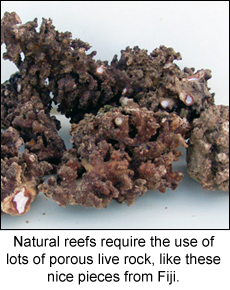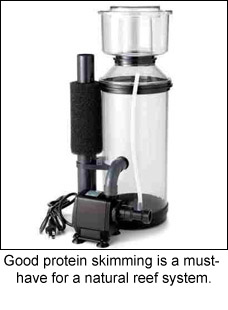Reef, Au Natural!


Do you remember those choose-your-own-adventure novels that kids read? The ones where every decision opens a new avenue of travel for the reader? In a funny way, marine husbandry is just like that. Every step of the way presents a new decision to be made. Where am I going to put this tank? How big should it be? Will it be acrylic or glass? Should I go with a deep sand bed or a wet dry sump? The questions go on and on, as each answer seems to carry with it another fork in the road. Such determinations are only further amplified in coral tanks, where early choices will have ramifications for the life the system. Fortunately, one the best aspects of the reef keeping hobby is its inherent flexibility. There are almost as many approaches to the process as there are aquarists employing them. Highlighted in this article is one possible approach, the natural reef.
A natural reef aquarium has many advantages, and possibly a drawback or two. For many aquarists, it can save money and time spent on mechanical equipment. When set up correctly, the natural reef will run like clockwork, with no more than about five minutes of work per day. The idea is to strip the marine nitrogen cycle, the waste stream, down to the bare minimum. To be more precise, the cycle is achieved through a method that is similar to the way it happens in the ocean, without a lot of equipment or devices. Of course, the natural reef has its limitations as well. Aquarists running very large tanks, or systems with a lot of fish biomass, will likely need to augment the filtration by mechanical means. Still, for tanks up to about 100 gallons, the natural approach is effective and inexpensive.
Let Us Take A Brief Look at What a Natural Reef Aquarium Entails.
In all aquariums, clean water is achieved through the cultivation of numerous species of beneficial bacterial colonies. It is how we provide the correct habitat for each species, and how we capture particulate waste, that distinguishes one set up from another. In some systems, for example, particulates are mechanically filtered out by some type of synthetic medium, such as a pre-filter sponge, filter sock, or a filter pad. In both mechanical and natural filtration, particulate and dissolved wastes can also be removed with a protein skimmer. Numerous other devices have been designed to add additional water quality control. UV sterilizers, ozonators, calcium reactors, and coil denitrators are just a few of the additional equipment options available to the marine aquarist.
The natural reef is different in that it does not require expensive and difficult to use equipment. In fact, the only piece of powered filtration equipment needed is a protein skimmer. For reasons explained later, protein skimmers may be considered part of the natural reef, in spite of their obvious mechanics. Instead of employing devices to control the waste stream and chemistry of the aquarium, the natural reef relies on natural or pseudo-natural processes and frequent water changes to maintain its cycles. Large-scale systems may find this approach impractical, but it works very well for sub-100 gallon tanks.
There are several very important components of the natural system: A) Large ratio of live rock, B) Sump/Refugium C) Shallow and deep sand beds, D) High turnover rate, and E) Protein skimming. Each part is important in its own right, but several can consolidated to simplify the equation. Looking at each component individually will give us a better idea of how they all fit together as a whole.

Live Rock Ratio
Starting with the most critical and expensive part of the system, the live rock, makes sense because it the source of the majority of the biological filtration. The porous nature of the rock allows water to penetrate its entirety. As the water approaches the center of the stone, its movement slows, oxygen levels begin to drop, and bacterial colonies change in response. The gradient of oxygen concentration is important for the processing of the three main problem chemicals, ammonia, nitrite, and nitrate. As previously mentioned, the different bacteria species that accomplish these feats are found in differing areas, according to the oxygen gradient. Where nitrogen cycling is concerned, the more live rock the better. Another benefit of the additional live rock is its contribution to calcium hardness, alkalinity, and other micronutrient levels. Because live rock is basically old coral skeletons, it already contains excellent ratios of these beneficial chemicals.
Having a good amount of high quality live rock is essential to maintaining good water quality in a natural reef. Conventional wisdom says that the system overall should contain between one and two pounds of live rock per gallon of water, but a natural reef demands that you maintain at least a 1.5:1 ratio. More is better, if it is affordable and there is enough space. If you have more rock than will fit in your main tank, a sump is a great place for the excess.
Sump/Refugium
Though serving somewhat different functions, it is very effective to combine the sump and refugium components into one. The sump, traditionally, is a reservoir that expands the water volume of an aquarium system, and provides space within which ugly equipment can be hidden. More and more often, we see the sump as a place to include a Deep Sand Bed (DSB, more on this later) and the macroalgae that makes up the refugium. People even take advantage of the refugium lighting and make egg-crate grow-out racks for coral frags. In some cases, nutrient hungry mangrove cuttings are housed in the sump as well.
A natural reef sump is relatively simple in construction. All you really need is a tank that will fit below your main aquarium (or wherever you have decided it should go). Size recommendations vary somewhat, usually between 25 and 30% of the main displays volume. If possible, I suggest going as big as 50%, so long as you still have room to access the sump and its equipment. You can get away with as few as three staggered baffles. The first chamber is a great place to house the skimmer, a heater, and some extra live rock. In the second chamber, a deep sand bed will provide an excellent amount of additional denitrification power, along with a being a convenient location for macroalgae. Add a suspended light over this area and, voila, you have nice refugium. The macroalgae will consume nitrates and phosphates, keeping your tank cleaner, and outcompeting unsightly cyanobacteria and problem algae. You can also throw more live rock into your refugium and increase its capacity as a nutritious copepod nursery for your livestock. The third, and final, chamber contains just a return pump. This is the section where you will measure the tanks evaporation rate.
Shallow and Deep Sand Beds
Live sand is a very important part of the natural reef tank. Not only do the sand grains offer a massive surface area available for bacterial colonization, the grains pack together in such a way that another oxygen gradient occurs. In some cases, denitrification can happen very near the surface, but certainly by a depth of two inches, anoxia is nearly complete. In most cases, a sand bed in a main display does not exceed two to three inches deep. For some, a visible cross-section of sand is unsightly. For others, having more sand simply takes away space in the display. A deep sand bed is almost always housed in a sump, out of view from onlookers, and its main function is to facilitate denitrification. Deep sands beds rarely exceed six inches deep, and have been used to varying success by different aquarists. Although they certainly perform a denitrification duty, they have also been implicated in hydrogen sulfide contamination and Old Tank Syndrome (OTS). The exact explanation behind these problems is unclear, but it may the use of wrongly sized sand grains that creates the proper conditions for either or both ailments.
High Turnover Rate.
Turnover, which is simply the sum total flow rate in the system, is very important in a natural reef tank. Good water flow helps remove waste products from corals and other invertebrates. It also builds stronger fish, because they must do more work to move around. If currents are aimed in multiple directions, either simultaneously or rotationally, the build-up of nitrogenous sludge and anoxic dead zones is minimized. You want to keep particulate waste suspended, so that it is eventually captured and removed by the protein skimmer.
To achieve high turnover rates without harming your livestock, angle powerheads and return lines toward the sides and front of the aquarium to distribute the force. Crossing the streams (insert Ghostbusters pun here) helps to create unpredictable turbulence that will reach more areas. You may also want to establish flow directly across the back of the tank, behind the live rock. To reduce the number of powerheads you need, there are several good options. You can employ a Switching Current Water Director (SCWD) device that uses water pressure from the return pump to flip a geared diverter arm back and forth, continuously redirecting the current. In addition, there are aquarium-specific power strips which have built-in oscillating outlets to rotate through the powerheads plugged into each one. Many powerheads now also come with current diverting attachments, and some high end brands like Tunze and Koralia make adjustable switch boxes. To calculate turnover rate, add up the GPH number of each powerhead in the tank, along with the flow rate of the return line where it enters the display. The goal is to reach 10X to 20X turnover using this calculation.

Protein Skimming.
The final piece of the natural reef puzzle is the protein skimmer. Protein skimming is considered, by some, to be a form of mechanical filtration. While there is no doubt that the process uses mechanical means to add air and move water from one location to another, the waste removal itself is not a mechanical process, per se. Instead of using a synthetic filter material to capture particulates, the protein skimmer uses air bubble to do so. It mimics the process by which waves cleanse coastal waters of proteinaceous wastes. If you live by the sea, you will understand what I mean. Sea foam, the brown funky stuff the develops in breakers, is analogous to skimmate, and performs a similar function. The added benefit of protein skimming is that it increases the dissolved oxygen content of your tank water. This is important because oxygen does not dissolve is saltwater as well as it does in fresh. Protein skimming exposes the water to more air, thereby facilitating oxygens dissolution.
The Final Touches
The finishing act for a natural reef tank is truly simple. Just do regular water changes. Change out at least 10% each week or 20% every other week, using a high quality, reef-specific synthetic salt mix. If you have a Total Dissolved Solids (TDS) meter or a refractometer, you can do the entire water change in less than 5 minutes. Be sure to also take a moment and suck out any sludge that develops in the areas water currents fail to reach. Depending on what you care for, you may also want to use a high-quality micronutrient supplement. Remember not to overfeed, and you are well on your way to having a fantastic natural reef.
Works Cited:
Brightwell, C.R.Marine Chemistry Neptune City: T.F.H Publications, 2007.
Brightwell, C.R. The Nanoreef Handbook. Neptune City: T.F.H Publications, 2006.
DelFavero, Carl. Aquarium Keeping & Rescue; The Essential Saltwater Handbook & Log. Neptune City: T.F.H Publications, 2005.
Tullock, John H. Natural Reef Aquariums; Simplified Approaches to Creating Living Saltwater Microcosms. Neptune City: T.F.H Publications, 2001.